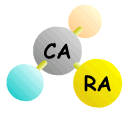| This is
the official website of CARA (Computer Aided
Resonance Assignment), which is the new application
for the analysis of NMR spectra and computer aided
resonance assignment developed at and used by the
group of Prof. Dr. Kurt Wüthrich, Institute of
Molecular Biology and Biophysics, ETH Zürich.
CARA is on one hand the name of an
optimized process model for the analysis and
assignment of NMR spectra, and on the other hand the
name of an interactive, graphical computer program
supporting that process. The computer program CARA
is a complete implementation of the conceptual model
formally introduced in the Ph.D. thesis of
Rochus
Keller. It can be seen as a proof-of-concept of this
model and thus as a side effect of the Ph.D.
project. The model itself is able to describe and
capture all information coming up during the
analysis and resonance assignment of NMR spectra and
to ensure consistency.
CARA is a modern, efficient computer program
featuring a state-of-the-art graphical user
interface (GUI) with many usability features (like
undo/redo) and a look and feel commonly accepted by
the community. It is completely platform
independent, offering identical features on all
platforms. The program is currently deployed on
Microsoft Windows (9x, ME, 2k, XP), Linux, Macintosh
OS X, Sun Solaris and Silicon Graphics IRIX. Since
CARA simply consists of a single executable file,
installation is very easy (no libraries and the like
are needed). Everything is written in ANSI C++ (more
than hundred thousand lines of code), adhering to
modern software engineering standards. The program
is therefore very fast, maintainable, extensible and
adaptable to future developments.
CARA follows a semi-automatic approach and causes a
significant increase of process efficiency and a
decrease of error probability. Contrary to previous
solutions like XEASY, whose information management
is primarily based on peaklists, CARA makes use of a
central repository able to manage abstract and
semantically interlinked information objects. The
availability of this repository allows to
dynamically calculate the needed projections (e.g.
the cross-peaks expected of a concrete spectrum) by
means of incremental inference algorithms. Further
concepts have been developed to simulate the
magnetization pathways of NMR experiments, to
integrate cross-peaks and to back-calculate and
efficiently store NMR spectra. CARA also contains a
powerful scripting language which allows to
implement algorithms, user interfaces and custom
persistent data structures.
This website is maintained by Rochus
Keller,
rkeller@nmr.ch |

